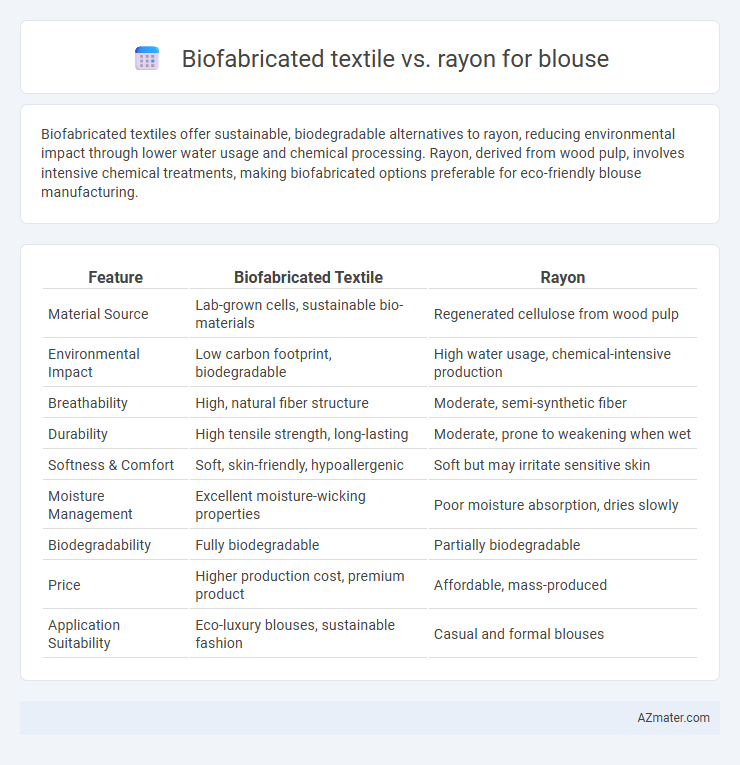Biofabricated textiles offer sustainable, biodegradable alternatives to rayon, reducing environmental impact through lower water usage and chemical processing. Rayon, derived from wood pulp, involves intensive chemical treatments, making biofabricated options preferable for eco-friendly blouse manufacturing.
Table of Comparison
| Feature | Biofabricated Textile | Rayon |
|---|---|---|
| Material Source | Lab-grown cells, sustainable bio-materials | Regenerated cellulose from wood pulp |
| Environmental Impact | Low carbon footprint, biodegradable | High water usage, chemical-intensive production |
| Breathability | High, natural fiber structure | Moderate, semi-synthetic fiber |
| Durability | High tensile strength, long-lasting | Moderate, prone to weakening when wet |
| Softness & Comfort | Soft, skin-friendly, hypoallergenic | Soft but may irritate sensitive skin |
| Moisture Management | Excellent moisture-wicking properties | Poor moisture absorption, dries slowly |
| Biodegradability | Fully biodegradable | Partially biodegradable |
| Price | Higher production cost, premium product | Affordable, mass-produced |
| Application Suitability | Eco-luxury blouses, sustainable fashion | Casual and formal blouses |
Introduction to Biofabricated Textiles and Rayon
Biofabricated textiles are innovative materials produced through biological processes using microorganisms or cultured cells, offering sustainable and biodegradable alternatives to traditional fabrics. Rayon, a semi-synthetic fiber derived from cellulose sources such as wood pulp, undergoes extensive chemical treatment and is widely used for its smooth texture and breathability in blouses. Comparing biofabricated textiles to rayon highlights the environmental advantages of reduced chemical usage and lower carbon footprint inherent in biofabrication technologies.
Origins and Production Methods
Biofabricated textiles originate from laboratory-grown materials such as microbial cellulose or cultured proteins, produced through sustainable biotechnological processes that minimize resource consumption and environmental impact. Rayon is a semi-synthetic fiber derived from cellulose extracted from wood pulp or cotton linters, undergoing chemical treatments like viscose or lyocell methods to regenerate fibers. The biofabrication process relies on cellular agriculture and fermentation, offering a renewable alternative to the chemically intensive and resource-heavy production of rayon.
Material Composition and Sustainability
Biofabricated textiles for blouses are produced using microbial or cellular processes that generate protein-based fibers, offering a renewable and biodegradable alternative to traditional materials. Rayon, derived from chemically processed cellulose fibers, involves significant water and chemical usage, raising environmental concerns despite its biodegradability. Biofabricated textiles demonstrate superior sustainability through reduced resource consumption and minimized toxic byproducts compared to rayon, aligning with eco-friendly fashion goals.
Environmental Impact Comparison
Biofabricated textiles for blouses generate significantly lower greenhouse gas emissions and water usage compared to rayon, which relies on chemically intensive processes and deforestation. The production of biofabricated materials involves sustainable cultivation and minimal chemical inputs, drastically reducing soil and water pollution. In contrast, rayon manufacturing contributes to habitat destruction and toxic effluent discharge, leading to adverse ecological effects across its supply chain.
Comfort and Wearability Factors
Biofabricated textiles offer superior breathability and moisture-wicking properties compared to rayon, enhancing comfort during extended wear. Their natural fiber composition reduces skin irritation and promotes better airflow, making them ideal for sensitive skin and hot climates. Rayon, while smooth and lightweight, tends to retain moisture and may cause discomfort in humid conditions due to its lower breathability.
Durability and Care Requirements
Biofabricated textiles for blouses offer superior durability compared to rayon, exhibiting enhanced resistance to wear, stretching, and pilling due to their engineered fiber structures. Unlike rayon, which tends to weaken and lose shape after repeated washing, biofabricated fabrics maintain tensile strength and colorfastness with minimal fading. Care requirements for biofabricated textiles are generally lower, often tolerating machine wash cycles and avoiding the delicate handling mandated by rayon's susceptibility to water-induced shrinkage and fiber degradation.
Aesthetic Qualities and Design Flexibility
Biofabricated textiles offer superior aesthetic qualities with their unique textures and natural luster, enhancing the visual appeal of blouses through innovative surface patterns and color integration. These materials provide exceptional design flexibility by enabling custom shapes, intricate details, and sustainable dyeing techniques that rayon often cannot achieve due to its uniform synthetic nature. Compared to rayon, biofabricated textiles support more creative freedom in blouse designs, combining eco-friendly production with enhanced tactile and visual dimensions.
Cost and Market Availability
Biofabricated textiles typically incur higher production costs compared to rayon due to advanced biotechnology and limited large-scale manufacturing, resulting in less market availability and niche positioning. Rayon, derived from cellulose fibers, offers a more affordable price point and widespread market presence, making it a common choice for blouse fabric. Despite higher costs, biofabricated textiles appeal to sustainability-focused consumers seeking innovative alternatives to conventional rayon.
Consumer Perceptions and Trends
Biofabricated textiles are gaining traction among eco-conscious consumers due to their sustainable production methods and reduced environmental impact compared to traditional Rayon. Consumer perceptions favor biofabricated fabrics for their innovation, biodegradability, and alignment with ethical fashion trends, driving demand in the blouse market. Market trends indicate a growing preference for transparent supply chains and materials with lower carbon footprints, positioning biofabricated textiles as a compelling alternative to Rayon.
Future Outlook: Innovation in Blouse Fabrics
Biofabricated textiles are revolutionizing blouse fabric innovation by offering sustainable, biodegradable alternatives to traditional rayon, which is derived from chemically processed wood pulp. Advances in biotechnology enable the development of biofabricated fibers that provide enhanced breathability, strength, and moisture management, addressing the environmental concerns tied to rayon production. Emerging trends indicate a growing market preference for eco-friendly textiles with reduced carbon footprints, positioning biofabricated fabrics as the future standard for high-performance, sustainable blouses.

Infographic: Biofabricated textile vs Rayon for Blouse
 azmater.com
azmater.com